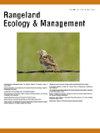牧场之外:商业风险与牧场管理决策综述
IF 2.4
3区 环境科学与生态学
Q2 ECOLOGY
引用次数: 0
摘要
农业领域的企业风险管理(BRM)项目旨在使生产者能够更好地保护其农场,使其免受对其业务可持续性和复原力的威胁。虽然BRM计划被广泛认为对生产者有益,但这些计划在多大程度上可能引起负面的环境外部性仍未得到充分研究,特别是在牧场管理方面。本综述的目的是调查BRM计划与草地及其相关的多物种栖息地自愿保护之间的联系,以及推动BRM、推广或其他政府计划被肉牛生产商采用的因素。本综述的第二个重点包括确定激励采用有益管理实践(BMP)和草地转换的因素。使用多种搜索工具和术语,我们的搜索策略得到了30篇符合纳入标准的文章,其中4篇是综述,14篇是针对生产者的调查,11篇进行了实证分析,1篇使用了空间分析。从这些文章中,我们能够回答我们的五个主要全球研究目标。一些研究发现,BRM项目与负面环境影响(包括促进草地转化)之间存在联系。研究发现,生产者的年龄、受教育程度、以前参与过政府项目以及外部动机等特征会影响采用BMP或新BRM项目的可能性。研究还发现,制作人更喜欢个人主导的风险管理策略,更喜欢通过独立自学或向值得信赖的专业人士学习风险。研究缺口包括生产者期望的政府支持水平,非作物保险BRM项目与牧场转换之间的联系,以及BRM与牧场管理决策之间的联系。本文章由计算机程序翻译,如有差异,请以英文原文为准。
Beyond the Pasture: A Review of Business Risk and Rangeland Management Decisions
Business risk management (BRM) programs in agriculture aim to enable producers to better protect their farms against threats to the sustainability and resilience of their business. While BRM programs are broadly considered beneficial to producers, the extent to which these programs could evoke negative environmental externalities remains understudied, especially concerning rangeland management. The purpose of this review was to investigate the link between BRM programs and the voluntary conservation of grasslands and its associated multiple species habitat, as well as the factors driving adoption of BRM, extension, or other government programs by beef cattle producers. A secondary focus of this review included identifying the factors motivating the adoption of beneficial management practices (BMP) and grassland conversion. Using a variety of search tools and terms, the application of our search strategy resulted in 30 articles meeting inclusion criteria, of which four were reviews, 14 were producer focused surveys, 11 conducted empirical analyses, and one utilized spatial analysis. From these articles, we were able to answer our five main global research objectives. Several studies found a link between BRM programs and negative environmental effects (including motivating grassland conversion). Producer characteristics such as age, education level, previous participation in government programs, and external motivations were found to impact the likelihood of adopting a BMP or new BRM program. Producers were also found to favour individually-led risk management strategies, and preferred learning about risk through independent self-study or from a trusted professional. Research gaps included the level of governmental support desired by producers, a connection between non-crop insurance BRM programs and rangeland conversion, and connections between BRM and rangeland management decisions.
求助全文
通过发布文献求助,成功后即可免费获取论文全文。
去求助
来源期刊

Rangeland Ecology & Management
农林科学-环境科学
CiteScore
4.60
自引率
13.00%
发文量
87
审稿时长
12-24 weeks
期刊介绍:
Rangeland Ecology & Management publishes all topics-including ecology, management, socioeconomic and policy-pertaining to global rangelands. The journal''s mission is to inform academics, ecosystem managers and policy makers of science-based information to promote sound rangeland stewardship. Author submissions are published in five manuscript categories: original research papers, high-profile forum topics, concept syntheses, as well as research and technical notes.
Rangelands represent approximately 50% of the Earth''s land area and provision multiple ecosystem services for large human populations. This expansive and diverse land area functions as coupled human-ecological systems. Knowledge of both social and biophysical system components and their interactions represent the foundation for informed rangeland stewardship. Rangeland Ecology & Management uniquely integrates information from multiple system components to address current and pending challenges confronting global rangelands.
 求助内容:
求助内容: 应助结果提醒方式:
应助结果提醒方式:


